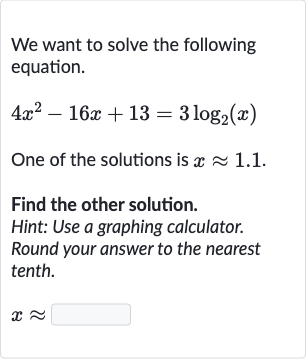Full solution
Q. We want to solve the following equation.One of the solutions is .Find the other solution.Hint: Use a graphing calculator.Round your answer to the nearest tenth.
- Understanding the Equation: First, we need to understand that the equation given is a transcendental equation because it involves both a polynomial and a logarithmic function. To find the solution, we will use a graphing calculator to plot both sides of the equation as separate functions and look for their points of intersection.Let's define two functions:We are given that one solution is approximately . We need to find the other solution.
- Defining the Functions: Using a graphing calculator, we plot the two functions and on the same set of axes. We look for the points where the graphs intersect, which represent the solutions to the original equation.
- Plotting the Functions: After plotting the functions, we find that there are two points of intersection. One is near , which we already know. The other intersection point will give us the second solution to the equation.
- Finding the Intersection Points: Using the graphing calculator's function to find the intersection point, we can determine the -coordinate of the second point of intersection, which is the other solution to the equation.
- Determining the Second Solution: The graphing calculator gives us the -coordinate of the second intersection point. We round this value to the nearest tenth to get our final answer.
More problems from Scale drawings: word problems
QuestionGet tutor help
QuestionGet tutor help
QuestionGet tutor help
QuestionGet tutor help
QuestionGet tutor help
QuestionGet tutor help
QuestionGet tutor help
QuestionGet tutor help
QuestionGet tutor help

